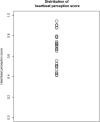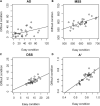Interoceptive accuracy correlates with precision of time perception in the millisecond range
- PMID: 36452334
- PMCID: PMC9701738
- DOI: 10.3389/fnins.2022.993491
Interoceptive accuracy correlates with precision of time perception in the millisecond range
Abstract
It has been proposed that accuracy in time perception is related to interoceptive accuracy and vagal activity. However, studies investigating time perception in the supra-second range have provided mixed results, and few studies have investigated the sub-second range. Moreover, there is a lack of studies investigating the relationship between precision in time perception and interoceptive accuracy. A recent meta-analytic review of neuroimaging studies proposed a dynamic interaction between two types of timing processing-an endogenous time keeping mechanism and the use of exogenous temporal cues. Interoceptive accuracy may affect both accuracy and precision of primary temporal representations, as they are generated based on the endogenous time keeping mechanism. Temporal accuracy may vary when adapted to the environmental context. In contrast, temporal precision contains some constant noise, which may maintain the relationship with interoceptive accuracy. Based on these assumptions, we hypothesized that interoceptive accuracy would be associated with temporal precision in the sub-second range, while vagal activity would be associated with temporal accuracy. We used the temporal generalization task, which allowed us to calculate the indices of temporal accuracy and temporal precision in line with the existing research, and also compute the index of participants' sensitivity according to the signal detection theory. Specifically, we investigated whether (1) interoceptive accuracy would correlate with temporal accuracy, temporal precision, or sensitivity and (2) resting-state vagal activity would correlate with temporal accuracy, temporal precision, or sensitivity. The results indicated that interoceptive accuracy was positively correlated with temporal precision as well as sensitivity, but not with temporal accuracy, in the sub-second range time perception. Vagal activity was negatively correlated only with sensitivity. Furthermore, we found a moderation effect of sensitivity on the relationship between vagal activity and perceived duration, which affected the association between vagal activity and temporal accuracy. These findings suggest the importance of precision as an aspect of time perception, which future studies should further explore in relation to interoception and vagal activity, and of the moderation effects of factors such as participants' sensitivity in this context.
Keywords: accuracy; interoceptive accuracy; precision; sensitivity; signal detection theory; temporal generalization task; time perception; vagal activity.
Copyright © 2022 Uraguchi, Maulina and Ohira.
Conflict of interest statement
The authors declare that the research was conducted in the absence of any commercial or financial relationships that could be construed as a potential conflict of interest.
Figures





Similar articles
-
Disconnected - Impaired Interoceptive Accuracy and Its Association With Self-Perception and Cardiac Vagal Tone in Patients With Dissociative Disorder.Front Psychol. 2018 Jun 27;9:897. doi: 10.3389/fpsyg.2018.00897. eCollection 2018. Front Psychol. 2018. PMID: 29997537 Free PMC article.
-
Effects of interoceptive training on decision making, anxiety, and somatic symptoms.Biopsychosoc Med. 2020 Mar 17;14:7. doi: 10.1186/s13030-020-00179-7. eCollection 2020. Biopsychosoc Med. 2020. PMID: 32206084 Free PMC article.
-
Interoceptive influences on peripersonal space boundary.Cognition. 2018 Aug;177:79-86. doi: 10.1016/j.cognition.2018.04.001. Epub 2018 Apr 11. Cognition. 2018. PMID: 29655026
-
Embodied feelings-A meta-analysis on the relation of emotion intensity perception and interoceptive accuracy.Physiol Behav. 2022 Oct 1;254:113904. doi: 10.1016/j.physbeh.2022.113904. Epub 2022 Jul 9. Physiol Behav. 2022. PMID: 35820627 Review.
-
Classifying individual differences in interoception: Implications for the measurement of interoceptive awareness.Psychon Bull Rev. 2019 Oct;26(5):1467-1471. doi: 10.3758/s13423-019-01632-7. Psychon Bull Rev. 2019. PMID: 31270764 Free PMC article. Review.
Cited by
-
The Utility of Heartrate and Heartrate Variability Biofeedback for the Improvement of Interoception across Behavioural, Physiological and Neural Outcome Measures: A Systematic Review.Brain Sci. 2024 Jun 5;14(6):579. doi: 10.3390/brainsci14060579. Brain Sci. 2024. PMID: 38928579 Free PMC article. Review.
-
Interoceptive signals and emotional states shape temporal perception through heart rate modulation.Front Psychol. 2025 Jul 3;16:1610347. doi: 10.3389/fpsyg.2025.1610347. eCollection 2025. Front Psychol. 2025. PMID: 40678439 Free PMC article.
References
LinkOut - more resources
Full Text Sources

